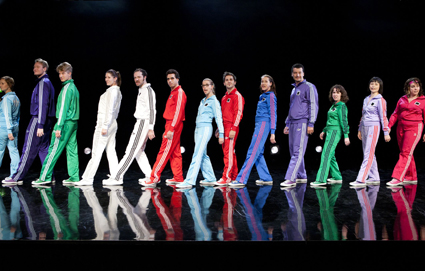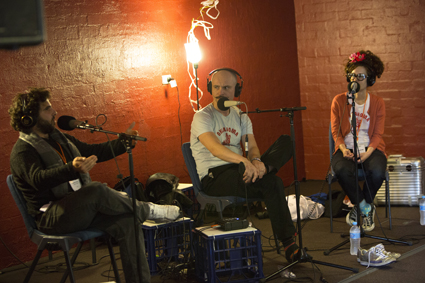You’ll stop seeing me as your dancing monkey
David Williams: Nature Theater of Oklahoma, Life and Times, MIAF

Nature Theater of Oklahoma, Life and Times 1-4
photo Anna Stocher/Burgtheater Wien
Nature Theater of Oklahoma, Life and Times 1-4
I spoke with Pavol Liska and Kelly Copper, the Artistic Directors of Nature Theater of Oklahoma, ahead of their Melbourne International Arts Festival season of Life and Times: Episodes 1-4. An epic 10-hour performance that narrates the life story of Kristin Worrall, one of the company members, Life and Times will eventually have 10 episodes with a combined running time of 24 hours.
The company’s earlier work No Dice, presented at the Sydney Festival in 2009, was an astonishingly inventive four-hour musing on storytelling constructed from recorded phone conversations.
Why try and cover the entire life of a person?
PL Remembering No Dice (see RT89), the question is ‘can you tell me a story?’ You know, any story. So that show became about the failure to tell a story, and then in the process of failing to tell a story, we told many different stories. And we wanted to do a story that is a life story: somebody’s—a person’s story. So I called Kristin and I didn’t expect that she would talk, ah, for so long. I expected that she would tell me her life story in maybe a couple of hours, but at the end of the first phone call she was at age eight, so I had to call again. At the end of the second phone call she was at age 14, etcetera etcetera until she was at age 34, I believe. And so, the attention that she took, and the gift that she gave us, we thought that it deserved an epic treatment. It felt like a goldmine, and it felt like—why keep looking further? Why keep trying to find another text for another show when we have this and we can just dig down in it and stay inside it. For a long time.
Do you treat each episode differently in terms of performance style?
PL Well, Episode 1 is an opera/musical, depending on where you are and what you feel, like, is more, more glorified. Episode 2, it’s an exploration of dance to me. And Episodes 3 and 4 are done in the shape of a murder mystery.
Why a murder mystery?
PL We go into rehearsal with a problem—how do we turn this material into theatre? What does this material really want? And we throw many different ideas at it, until one of them really sticks. Like, the genre of murder mystery felt the most appropriate to this age and the ideas that it expressed. There is lot of confessional, you know; you start to experience religious inklings, the world gets out of joint. And the genre of murder mystery is always about a world that’s out of joint, that it tries to put back together somehow. Our sincere hope is that people see beyond the genre, beyond the parody. We really work hard to get past it, even though we really also work hard to put the genre in the foreground. To orient the audience. You always have to turn the material and open it up. We do a barbeque between Episodes 1 and 2.
KC The actors cook.
PL And we serve dessert between Episodes 2 and 3. So it’s continuous, you know, we have not been slack. The actors get out of Episode 1 and then go straight to the grills and start grilling, and then everybody goes around the building and gets their hamburgers.
KC We do like to keep the audience close to it.

Nature Theatre of Oklahoma at the Australian Theatre Forum
photo Penny Bradfield
Nature Theatre of Oklahoma at the Australian Theatre Forum
PL I want to create more time with people. It’s a necessity. When people ask me “why is the show so long?,” I say, “It’s too short.” What is it, 10 hours with a human being? It’s not that long. And I want to keep extending it so that we get something out of it, we get to know each other, and we have some kind of, you know, revelation. Something unexpected happens. And it’s hard to make something unexpected happen when you just do a show, when I’m performing, when I’m being a dancing monkey for you. What generally happens is that after five or six hours of being together you stop seeing me as your dancing monkey. You have to take your own responsibility. Do you have endurance? Do you have it in you? Have you prepared for this? In my experience the audience prepares, and they know that it is going to be long and there’s nobody really saying, “Oh I’ll just check it out for the first hour and see what happens.”
Nature Theater of Oklahoma, Life and Times: Episodes 1-4, Arts Centre, Melbourne International Arts Festival, 23-26 October
See also Jane McKernan’s review of Rambo Solo (2010); and Keith Gallasch’s account of No Dice (2009)
RealTime issue #116 Aug-Sept 2013 pg. 27






